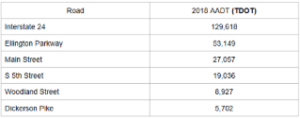Significance
Inner Loop
Spaghetti Junction makes up a small part of Nashville’s inner loop, the ring of Interstates 24, 40, and 65 that surrounds the city. The inner loop plays an important role in facilitating movement about the urban core while also defining the possibilities of adjacent neighborhoods. Meanwhile, Spaghetti Junction contains the only cloverleaf interchange design on the inner loop. The 2040 Regional Transportation Plan (RTP) highlighted this by claiming that “downtown interchanges, particularly on the East Bank should be redesigned from the current clover‐leaf design to a more appropriate, and less land hungry, urban form”. Studies are currently being conducted on the inner loop by a partnership including the GNRC, TDOT, and NCDC, providing a pressing opportunity to examine the extent of Spaghetti Junction’s overall impact.
Transportation Corridors
In addition to the inner loop, Spaghetti Junction connects to two important transportation corridors. Dickerson Pike runs north several miles from Spring Street to junctions with Briley Parkway and I-65. The corridor’s Route 23 is Nashville’s fourth-highest ridership bus line. Low-density development characterizes the area around Dickerson Pike, but an estimated 58,000 jobs are within a half mile of the corridor. The Northeast Transportation Corridor, which connects Downtown Nashville to Sumner County, also joins Spaghetti Junction by way of James Robertson Parkway and Main Street. Bus Route 56, which runs along the corridor, is MTA’s highest ridership route, and over 45,000 people live within a half mile of the corridor. The 2016 nMotion plan targeted the corridor for a light rail route, and it was considered a major priority in the RTP.
 Both corridors are vital to economic prosperity and regional transportation connections. Travel data, shown on the right, indicate that people can easily move to the area from surrounding regions and vice versa. Area businesses, such as Topgolf and even the Tennessee Titans, have used this characteristic to expand markets beyond the immediate area. This could be of value to future investors or private businesses. On the public side, the proximity of key transportation corridors and the excess space of Spaghetti Junction provides flexibility in exploring the placement, expansion, and maintenance of transit.
Both corridors are vital to economic prosperity and regional transportation connections. Travel data, shown on the right, indicate that people can easily move to the area from surrounding regions and vice versa. Area businesses, such as Topgolf and even the Tennessee Titans, have used this characteristic to expand markets beyond the immediate area. This could be of value to future investors or private businesses. On the public side, the proximity of key transportation corridors and the excess space of Spaghetti Junction provides flexibility in exploring the placement, expansion, and maintenance of transit.
Neighborhood Connectivity
Though access is generally unhindered for cars in the region, this detracts from the connectivity of the surrounding neighborhoods. Walking, biking, and the use of other micromobility options are made difficult by high-traffic roads and a lack of dedicated micromobility infrastructure. Two sections of Spaghetti Junction were given walkability index scores of 6.833 and 7.83 out of 100 (this describes the likelihood of walking based on built infrastructure). Both are “Below Average Walkable.” The census tracts containing Spaghetti Junction, 11800 and 11900, show that the percentage of workers who walk to their job is below the 3.1% target for 2020. This takes on additional significance considering that more than 11% of households in the adjacent census tracts do not own a vehicle.
Site Navigation
Introduction
Significance
Preliminary Research
Design Goals
Design Results & Recommendations
Further Research
